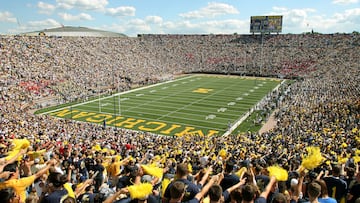Why is Michigan Wolverines’ football stadium known as ‘The Big House’? Seating capacity
Located in Ann Arbor, Michigan, ‘The Big House’ has been home to the Wolverines for almost a century.

Sports venues don’t come much bigger than Michigan Stadium. Dubbed ‘The Big House’ for a good reason, it is the largest stadium in the United States and also in the Western world. There are only two stadiums on the planet that can house more spectators - Narendra Modi Stadium in Ahmedabad, Gujarat, north west India which has a capacity of 132,000 and Rungrado 1st of May Stadium in North Korean capital Pyongyang which can seat 114,000.
Michigan Stadium’s capacity has steadily increased since its inauguration in 1927. When it opened its doors for the first time, for a game against Ohio Wesleyan on 1 October 1927, it contained 70 rows and could house a crowd of 72,000. Within a year, the stadium was expanded with its capacity raised to 85,752. Today, after decades of upgrades and revamps, the Wolverines’ home can seat 107,601 at full capacity. For football fans, it offers a unique and unforgettable experience when the regular season gets underway every fall.
Michigan stadium capacity 1927-2023
- 1927/28 72,000
- 1928-48 85,752
- 1949-54 97,239
- 1955-72 101,001
- 1973-91 101,701
- 1992-97 102,501
- 1998-2007 107,501
- 2008-09 106,201
- 2010-14 109,901
- 2015-present 107,601
Why is Michigan stadium called the Big House?
For obvious reasons, its immense size. The nickname was coined at some point in the mid-1980s by legendary ABC Sports commentator Keith Jackson during one of his inimitable college football broadcasts. Jackson was was ABC’s lead play-by-play announcer from 1987 to 1992, and continued commentating until his retirement in 2006.
The nickname had already appeared in print - Notre Dame running back Allen Pinkett was quoted as saying, “I’m looking forward to playing [against Michigan] in the Big House…” in an article published in the Weekly Detroit Free Press for 13 September 1985.
Pitch below ground level
Michigan Stadium was built on top of an underground spring which caused complications during its construction, forcing engineers to excavate land and build a large part of the structure lower than originally planned. Almost three-quarters of the stadium was built below ground level and according to an urban myth, a crane became engulfed by the soft foundations and eventually became irretrievable after sinking. It is believed to be still there, underneath the stadium to this day.





